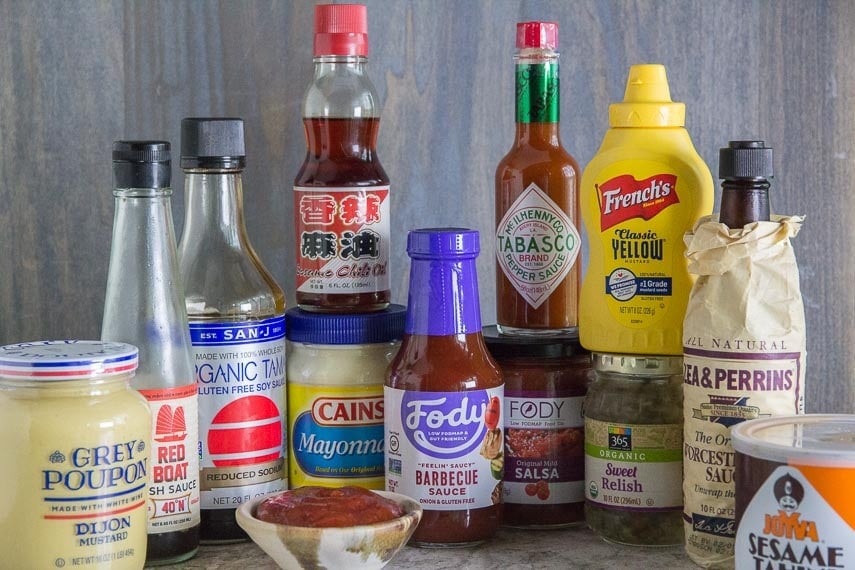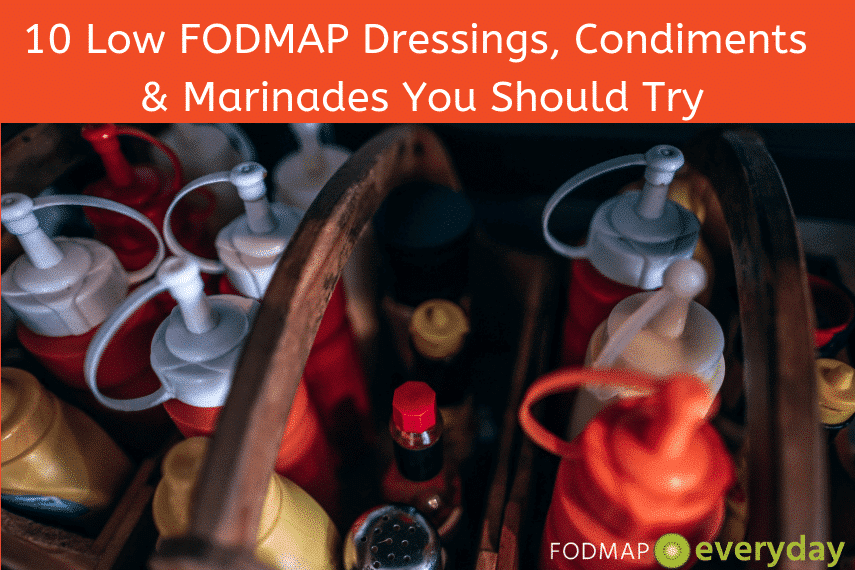The Ultimate Guide to Low FODMAP Condiments to Always Have on Hand
Ketchup, mustard, salsa, pickle relish, Worcestershire sauce, wasabi and mayonnaise… sometimes it is the condiments that makes the dish! This is your Ultimate Guide to Low FODMAP Condiments.
What Is a Condiment?
Good question. If you look at the “Condiments” section of the Monash University Low FODMAP Diet Smartphone App you will see items listed that we at FODMAP Everyday® do not typically place in that category, such as prepared dips, like Caviar Dip, fresh herbs, dried herbs and spices, and items like vanilla.
We will not be including those here. So we did use the app for direction, but applied our own lens.
To us a condiment is a prepared food item that is used to flavor or enhance food. Sometimes it is used as is, such as wasabi – just get in there and dab your sushi! But very often a condiment is used to flavor food during cooking and food preparation, such as Worcestershire sauce or mayonnaise. And then there are outside-the-box uses, such as in our Cucumber Wasabi Gimlet!
We have attempted to create a fairly complete list and we have included the items that you use most often – and have questions about.
Many condiments are low FODMAP – and some are not – and even the ones that are demand your keen attention to serving size, all of which we discuss below. Let’s dive in and take them alphabetically one-by one.
But First, A Note on Tablespoons
As always, we use the Monash University Low FODMAP Diet Smartphone App and suggest that you do the same. It is the Monash folks who are doing the lab testing of individual ingredients and prepared foods and their information is trustworthy.
As Monash is based in Australia, their recommendations reference Australian tablespoons, which are larger than tablespoons EVERYWHERE else in the world. This is vitally important to understand when measuring during cooking and especially when suggested serving sizes ARE mere tablespoons, which is the case with most condiments.
The takeaway is that when Monash says you can have a tablespoon or two of something, it is a more generous amount than you might realize – if you live outside of Australia.
Low FODMAP Condiments – in Alphabetical Order
BBQ Sauce
This entry on the Monash University Low FODMAP Diet App is a curious one. It lists generic BBQ Sauce and there is also FODY Low FODMAP BBQ Sauce. Both types of BBQ sauce are listed on the app as low FODMAP in 2 tablespoon amounts BUT, and this is a big but, in the listing for the generic type Monash suggests to read labels and “limit intake” of any BBQ sauce that contains garlic and/or onion.
The problem is that unless they are formulated to be low FODMAP, such as the FODY product, most do contain those high FODMAP ingredients and often HFCS as well.
Generic BBQ sauce is suggested at 2 tablespoons (46 g) and FODY BBQ Sauce is also suggested at 2 tablespoons, although theirs weighs 33 g.
Capers (salted and in vinegar)
These little flower buds (yes, that’s what they are!) offer little salty bites of flavor to anything you might add them to, such as chicken piccata, pasta puttanesca or eggplant caponata. Monash suggests servings of either kind at 1 tablespoon (8 g).
Chili Oil
Chili oil is an Asian condiment that is made of sesame oil and hot chiles. Both of those items are low FODMAP, although this condiment itself has not been tested. It has the flavor of toasted sesame oil along with the heat of hot chiles and we love using it with Chinese-inspired stir-fries. Use it sparingly as it is quite spicy and note that hot spicy foods can trigger IBS symptoms for some.
Cocktail Sauce
We love a good cocktail sauce for cold steamed shrimp and other seafood. If making homemade you can control the ingredients, which are typically ketchup (or other tomato-based products), horseradish (see below) and low FODMAP spices, brown sugar, lemon juice and other ingredients.
The problem here is that it can de difficult to find a commercially prepared brand that does not contain high fructose corn syrup (HFCS). If you are particularly sensitive to fructose, then steer clear. Or, you could try it in small amounts and see how you do (see Ketchup entry below for more discussion on HFCS).
Fish Sauce
This salty, umami-packed sauce is low FODMAP in servings of 1 tablespoon (44 g). It is often incorporated into sauces with other ingredients and can bring a lot of flavor to your Asian-inspired cooking. Please note that the flavor will vary greatly brand to brand. I highly recommend Red Boat brand and that is what I use to test recipes. If you substitute other brands, chances are that your results will be much saltier, with a harsher taste.
Horseradish
Prepared grated horseradish is low FODMAP in amounts of 2 tablespoons (42 g). Check it out in our Short Ribs with Horseradish & Red Wine or our Lactose-Free Sour Cream Horseradish Sauce recipe and for a real treat, stir some into your hamburger meat next time you are making burgers. It’s fantastic.
Hot Sauce
Folks who like hot sauce are fanatical about it. Luckily there are many low FODMAP kinds. Just read the labels and you should be able to find many choices that simply list hot chiles, vinegar and salt. While this is a low FODMAP product, many people experience digestive issues when consuming spicy foods, so use your own good judgment and know your history of reactions. Try Tabasco or Texas Pete’s.
Ketchup
Ketchup is listed on the app in a few places, and Monash has varied recommended amounts. For FODY Tomato Ketchup, which is developed to be low FODMAP.
For other ketchups, the low FODMAP amount recommended as 13 g, or “½ sachet”. This is equal to about 2 ¼ teaspoons – and this is for both ketchup that is made with high-fructose corn syrup (HFCS) and that made without but sweetened with sucrose.
This might be confusing, since HFCS is high FODMAP. It all relates to the serving size, which is small. Always pay attention to portions.
The takeaway is that you can dollop a bit of ketchup on your burgers, dogs and French fries. Enjoy! Speaking of French Fries check out our Best Oven-Baked Fries; we think they are even better than fried!
Mayonnaise
You can make mayonnaise or you can buy mayonnaise. Most of us buy it and we prefer Hellman’s Real Mayonnaise in the Test Kitchen for its flavor and texture. It should be noted that the ingredient panel lists “natural flavors” and Unilever, the manufacturer, initially would not confirm or deny the presence of natural flavors derived from garlic and/or onion claiming “proprietary” information.
On a phone call to Unilever customer service on June 5, 2018, however, a customer service representative told me that she had done research herself on an internal system and that the product does contain natural flavors derived from garlic and/or onion. After pressing, we did receive an email. here it is:
“Thank you so much for contacting Hellmann’s!
We appreciate your patience in this inquiry. There is absolutely no garlic in our Hellmann’s products.
Whole form, dehydrated, pulverized, and powdered onion are listed separately on the labels under their common or usual name and would not be contained within a spice or natural flavor listing. However, an essential oil, oleoresin, essence or extractive of onion may be declared as a natural flavor. Although these compounds have traditionally lower proteinaceous compounds, if you have a high sensitivity to any of them, we suggest you do not consume these products. We hope this information helps.”
The fact is that we have done just fine with Hellman’s in terms of digestibility, but you have to make your own assessment. Cains mayonnaise is one U.S. brand that lists all of its ingredients and does not contain onion and/or garlic; its flavor is very different from Hellman’s. Use your own judgment.
Monash sets the serving size for mayonnaise at 2 tablespoons (40 g) for both regular and low fat mayonnaise.
Mint Jelly & Mint Sauce (Thick and Thin)
This condiment is favored by many alongside lamb. The jelly version is sweet and the sauce versions have a bracing vinegary quality (most often) and all of them are given the Green Light by Monash at 1 tablespoon (20 g).
Miso
We love this fermented soy paste and are so thankful that it is low FODMAP in 12 gram portions, which equals about 2 U.S. teaspoons. Miso is typically used while cooking and incorporated into recipes, such as in our Miso Lime Glazed Salmon. You can read more about miso and other soy ingredients in our articles, Soy Products, Low FODMAP or Not? and also Soy and the Low FODMAP Diet.
Mustard
There are many kinds of mustard available: yellow, brown, Dijon and coarse ground are the most common. Yellow, “mild” (which is like “brown” mustard) and Dijon are all listed on the app.
What Monash calls “mustard” is equivalent to what many of us call “yellow mustard” and you can have safe servings in 1 tablespoon (11 g) amounts. We believe the “mild” mustard in the app with the German flag is similar to “brown mustard”, like Gulden’s, and that can be enjoyed in 2 tablespoon (30 g) amounts.
Curiously, while the Dijon mustard is suggested in 1 tablespoon (23 g) amounts, the app also tell us that in amounts greater than ¾ cup (230 g) that it will veer into high FODMAP territory. That’s a huge difference between 1 tablespoon and ¾ cup! Our takeaway is that you might just do fine with larger amounts than 1 tablespoon of Dijon; of course your experience should be your guide.
Monash also specifically states that you should read labels and “limit intake” of any mustard that contains garlic and/or onion.
Check out our One-Bowl Maple Mustard Sauce for a super versatile recipe that we love with poultry and pork – even fish!
Oyster Sauce
This slightly fishy (in a good way) Asian condiment is low FODMAP in 1 tablespoon (20 g) amounts. We like Lee Kum Kee and Kikkoman and you can see how it works its magic in our recipe for Tofu with Baby Bok Choy & Oyster Sauce.
Salsa
With salsa there is good news and there is bad news. Let’s get the bad news out of the way: most traditionally prepared salsas, whether they are from a jar or made at home, will contain onion and a fair amount of it, making the salsa high FODMAP.
The good news is that there are low FODMAP salsas on the market, such as FODY Salsa, in both Mild and Medium. These are tested in a lab for FODMAP content and have received Monash University Low FODMAP Certification in amounts of 1 ½ tablespoons (30 g). That’s enough to dip several corn chips! Or check out our 7-Layer Dip!
Soy Sauce
Soy can be complicated as some soy products are low FODMAP (firm tofu, soy sauce and miso to name a few) and some are high FODMAP (silken tofu, soy milk made with whole soybeans, to name a few in this category).
Soy sauce is low FODMAP and can be enjoyed in amounts of 2 tablespoons (42 g), which is a very generous amount. We prefer naturally brewed soy sauce and you can read more about soy products in our article, All About Soy. For recipes head on over to our Sticky Maple Ginger Soy Chicken Wings or our Pork Shumai.
Sweet and Sour Sauce
This is a common condiment found in Chinese restaurants (Americanized ones, at any rate) and Monash says we can have portions of 2 tablespoons (44 g). The problem is that so many things from the Chinese restaurant menu that we want to dip into sweet and sour sauce are probably high FODMAP! So, approach carefully, but you can have a little of the sauce in your diet.
Wontons have been deemed low FODMAP by Monash, so you can dip fried wontons or dumplings with low FODMAP fillings in this thick, sweet and sticky sauce.
Tahini
We love this smooth, buttery, nutty tasting condiment and you might be missing out because at first glance it has a Red Light designation in the Monash app. Always click though the Red Light foods because you might go on to learn, such as in this case, that there is a Green Light serving. For tahini it is 1 tablespoon (20 g). It brings a classic nuance to hummus that we think you will love.
Vegetable/Pickle Relish
The title of this entry is the way Monash lists this product in the app. This is the green pickle relish that we happen to love on our burgers – and perhaps you thought you couldn’t have it, since it has a Red Light designation on the app!
Click through and you will see that you can have 1 tablespoon (20 g), which is actual a nice amount for a burger or a hot dog.
Wasabi Paste & Wasabi Powder
We love sushi and sashimi and in fact they make a great low FODMAP restaurant meal – if you pay attention to the possible high FODMAP aspects. In a restaurant you will be given wasabi paste, which may or may not have been made from wasabi powder.
Same goes for home preparation – you can start with prepared paste, or add water to wasabi powder to make a paste. Monash gives a Green Light to amounts of 2 tablespoons of paste (42 g) and 1 teaspoon of powder (5 g).
Note that none of Monash’s information on wasabi applies to freshly prepared wasabi, however, there are two key points to consider here: firstly, you will very rarely come across fresh wasabi anyway and secondly, as it is a type of horseradish, which is low FODMAP in 2 tablespoon (42 g) amounts, you could try it anyway and see how you do.
Worcestershire Sauce
If you read the label of most Worcestershire sauces you will see that it contains garlic and onion (and sometimes HFCS), which might seem contradictory to what you hear about those high FODMAP ingredients. Again, it comes down to serving size.
Monash recommends 2 tablespoons (42 g) as a serving, which is generous. We love to use it as a seasoning, such as in our Low FODMAP Caesar Salad Dressing and Everyday Meatloaf.










“As Monash is based in Australia, their recommendations reference Australian tablespoons, which are smaller than tablespoons EVERYWHERE else in the world.” They’re actually larger, as you imply later in the article.
Carolyn, how one word can make a difference! Thank you for your eagle eye. Hope you enjoy the rest of the article. I enjoyed writing it as well as the one on hot dogs; I never thought I would care so much about hot dogs! Edit is made. Again, thank you for taking the time to read our article and to communicate with us. Have a great weekend.
What is the volume of an Australian tablespoon in milliliters?
You can read more about this in our article on Tablespoons. Basically teaspoons are 5 ml. Australia uses FOUR to equal a tablespoon, therefore their tablespoons are 20 ml. Everywhere else in the world it is 3 teaspoons = 1 tablespoons to = 15 ml. Now at first this might not seem like a lot, but it is actually a significant difference. Think about if a recipe calls for 1 tablespoon of salt or baking powder or cinnamon. When it comes to something like raisins, if it is represented as “1 tablespoon” but it is Australian, then you can actually eat a third more!
Do they have the fody brand in grocery stores or do you have to order them
It depends on where you live! We do have them in our local market. Please refer to their STORE LOCATOR.
Thanks for your article! One thing I’m confused about is why the Monash app gives Sriracha sauce the green light. My understanding was that garlic should be avoided at any serving size if you can’t tolerate fructans…but even at a ‘high’ serve size of 1tbsp it’s still green…
Hi Marly, there are actually several condiments that have been lab-tested as low FODMAP in specific portions that contain garlic and/or onion and even honey. It all comes down to the amount of the ingredient in proportion to the serving size. What the Sriracha Monash app entry is telling us is that the garlic in the tested condiment is low enough not even to register its amount of fructans in those portions. You can see that it is actually the fructose that you have to pay attention to with this condiment. You might also enjoy this article.
Thanks for the speedy reply, Dédé – that’s great news as I’d thought even the slightest amount of garlic would rule something out, but this is encouraging!
My pleasure! How YOU digest something is what is key. The lab tests are where we start. AND even if something doesn’t sit well with you now, it might be okay 6 months down the road or so, so don’t give up!
Why is French’s mustard on the list of safe condiments? The last ingredient is garlic powder
Many condiments that have small amounts of garlic and/or onion have been lab tested by Monash and have been deemed low FODMAP in specific sizes, such as conventional ketchup (even with high fructose corn syrup), mayonnaise and Worcestershire sauce, to name a few. Check out our article on FDA labels, also the one on What Is A Low FODMAP Serving Size? and also on label reading. It is ALL about the quantity per serving size.
Hi
Which supermarkets have FODMAP friendly sauces and condiments for ibs in Australia.
Thank you
Sophia
You would have to check individual stores and/or check with the brands you are interested in. We will have a COLES shopping list coming up soon, FYI.
Which supermarkets have low fodmap sauces for ibs in Ireland please
I am not aware off-hand. Perhaps consider going our Facebook Group Low FODMAP for FOODIES. We are over 14k strong and the group is global; you might get some input there.
I am very confused, I’m new to all this.
Low FODMAP is a set off to ibs?
I’m going to join the fb page!!
Hi there. You can learn more about the low FODMAP diet HERE. It is a clinically proven diet for those with IBS and will help the great majority of those suffering. It can be confusing, especially at first, and is best undertaken with the help of a Registered Dietitian, at least for a few visits. FODMAPs are carbohydrates that have been proven to trigger IBS symptoms in a great majority of people. The diet helps you identify which FODMAPs are the greatest issue for you. The diet ends up looking very different for every IBS sufferer.
Why are you not specifying gluten-free oyster sauce and soy sauce?
While we actually do use gluten-free in our recipe testing and provide links for purchase, the diet is actually not a gluten-free diet and therefore this is not a requirement. You can read more about it in this article.Not gluten
Thanks very much for your helpful comments on sauces. So many of them have HFCS, which is practically poison for me. I’m curious about beans, which even in very small amounts–like two beans–make me very gassy. I can’t eat soy sauce either. And sadly edamame, which I love. Yet you indicate they’re OK in usual (small) amounts. Is that a different problem from FODMAP issues. Thanks.
FODMAP sensitivities vary hugely person to person, and also time to time. Some folks can tolerate a small amount of HFCS or fructans; others cannot, even thought those amounts are considered low FODMAP. Where are you in your FODMAP journey? If you are just starting out, your system might still be very sensitive. After conducting a structured Elimination and Challenge Phase you will gain much more info about your particular GI tract and reactions. Working with a dietitian can help you get to the bottom of your unique needs.